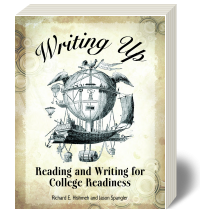

Writing Up: Reading and Writing for College Readiness
First Edition Hishmeh, Spangler, © 2016, 124 pages
This textbook is suitable for an introductory English composition course.
Request Examination CopyPrices and ISBNs
This title is available in the following formats.
|
Product
Description ISBN |
Description | ISBN | Bookstore (Net Price) |
Student (Retail Price) |
Excerpts
Description
Writing Up offers a complete curriculum for a basic writing, college readiness composition course. Each chapter begins with a strong "INTO" activity and with a reading that dictates both the writing and grammar activities that follow. This approach immediately (if indirectly) places students within the writing process. The focused conversation that comes out of the three part reading section offers a contextualized space for invention and planning. In short, the reading section of each chapter is where prewriting begins.
In the writing section that follows, students are made to enact additional planning and drafting steps, as they intuit their own ideas into conventional rhetorical patterns. As our classroom trials have repeatedly demonstrated, this inevitably leads students into the editing and revision steps of writing, as they wrestle to fit their original ideas into the syntactic and logical demands of template-based assignments. The Writing Up method offers a solution to the frustration that comes with "selling" process to (remediated and advanced) college writers. Writing Up does not teach process; rather, it gets students performing it.
Finally, in the grammar section that ends each chapter, students take a closer look and reflect upon how the grammar point emphasized in that chapter affected their reading of the piece and their execution of the writing exercises. The exercises in this section are divided into two parts, representing both traditional and more progressive approaches to grammar practice. Our systematic, innovative approach to teaching the writing process through these three integrated sections adds new meaning to that ubiquitous writing mantra: SHOW; DON'T TELL. While no pages are devoted to an abstracted description of the writing process, there is not a moment in any chapter where students are not fully immersed in it.
Writing Up is informed by several concepts of writing instruction that, though commonplace, are not readily available in one textbook: 1) That sound reading habits are inseparable from good writing habits 2) that imitation is a viable, natural method for learning the conventions of language 3) that grammar is best taught in a context and reinforced through rote practice. This book challenges mainstream methods in at least two important ways, asserting 1) that native English speakers seeking to become competent collegiate writers do not benefit from a ground-up approach to grammar or writing process, such approaches being superfluous to their immediate and perhaps long-term needs 2) that the stigma of remediation is reduced when the basic skills student is challenged, respected, and made accountable, rather than infantilized, marginalized and abetted 3) that certain types of reading (high canon literature and particular modes of writing (analytical and research-based) are NOT anathema to the basic skills dynamic. Our approach insists that repeated exposure to, and frequent use of, standard grammatical patterns provides a more logical, natural, and beneficial mode of learning than that which is offered in competing textbooks.
Overall, this book offers an alternative approach to prevailing models of basic writing instruction at the collegiate level, one that better addresses national trends in remediation such as acceleration. Writing Up challenges accepted methodologies of basic writing instruction that privilege a ground-up, prescriptive approach to grammar, and it challenges common problematic assumptions about the capabilities, interests, and needs of basic writing students.
Each Chapter of Writing Up includes the following Devices and Features: